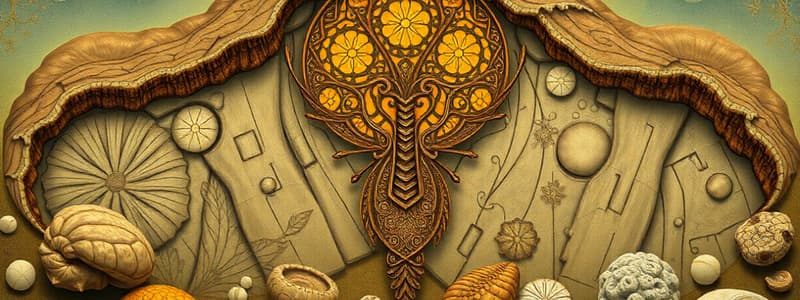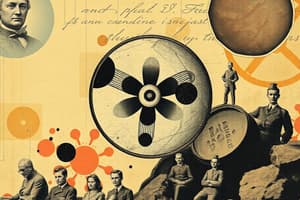Podcast
Questions and Answers
Which of the following lists the correct order of the geologic eons from oldest to most recent?
Which of the following lists the correct order of the geologic eons from oldest to most recent?
- Phanerozoic, Proterozoic, Archaean, Hadean
- Archaean, Hadean, Phanerozoic, Proterozoic
- Hadean, Archaean, Proterozoic, Phanerozoic (correct)
- Proterozoic, Phanerozoic, Hadean, Archaean
Why is the fossil record considered an incomplete snapshot of biological history?
Why is the fossil record considered an incomplete snapshot of biological history?
- Fossils are only found in specific geographic locations.
- Fossils only represent organisms from the Phanerozoic eon.
- Soft tissues never fossilize, leading to a loss of information.
- The process of fossilization is a rare occurrence. (correct)
Which of the following geological eras is the oldest?
Which of the following geological eras is the oldest?
- Mesozoic
- Cenozoic
- Proterozoic (correct)
- Paleozoic
What is the primary process by which organic matter in tissues becomes petrified during fossilization?
What is the primary process by which organic matter in tissues becomes petrified during fossilization?
Besides petrified remains, what other form can fossils take, providing evidence of past life?
Besides petrified remains, what other form can fossils take, providing evidence of past life?
Which condition is NOT crucial for fossilization to occur?
Which condition is NOT crucial for fossilization to occur?
What is the fundamental principle behind radiometric dating?
What is the fundamental principle behind radiometric dating?
What assumption allows scientists to use uranium-lead dating on zircon crystals?
What assumption allows scientists to use uranium-lead dating on zircon crystals?
What data was used to calculate the age of the Earth and solar system?
What data was used to calculate the age of the Earth and solar system?
In the context of geological time, what is the significance of the Precambrian?
In the context of geological time, what is the significance of the Precambrian?
Which of the following events occurred during the Proterozoic Eon?
Which of the following events occurred during the Proterozoic Eon?
The Cambrian explosion, a period of rapid diversification of animal life, marks the beginning of which eon?
The Cambrian explosion, a period of rapid diversification of animal life, marks the beginning of which eon?
What is the correct order of the three eras within the Phanerozoic eon, from oldest to most recent?
What is the correct order of the three eras within the Phanerozoic eon, from oldest to most recent?
Which of the following is a distinguishing characteristic of the Mesozoic Era?
Which of the following is a distinguishing characteristic of the Mesozoic Era?
What evolutionary event characterizes the Cenozoic Era?
What evolutionary event characterizes the Cenozoic Era?
Which mass extinction event is associated with the disappearance of non-avian dinosaurs?
Which mass extinction event is associated with the disappearance of non-avian dinosaurs?
Which of the following best describes the 'species vacuum' mentioned in relation to mass extinction events?
Which of the following best describes the 'species vacuum' mentioned in relation to mass extinction events?
If a rock sample contains a radioisotope with a half-life of 5,000 years, and the ratio of parent isotope to daughter element is 1:3, approximately how old is the rock?
If a rock sample contains a radioisotope with a half-life of 5,000 years, and the ratio of parent isotope to daughter element is 1:3, approximately how old is the rock?
Given that the Big Bang occurred approximately 13.8 billion years ago and the Earth formed approximately 4.54 billion years ago, what percentage of the universe's existence passed before the Earth came into being?
Given that the Big Bang occurred approximately 13.8 billion years ago and the Earth formed approximately 4.54 billion years ago, what percentage of the universe's existence passed before the Earth came into being?
If a paleontologist discovers a new fossil in a rock layer known to be from the Mesozoic Era, which of the following types of organisms would they be LEAST likely to find?
If a paleontologist discovers a new fossil in a rock layer known to be from the Mesozoic Era, which of the following types of organisms would they be LEAST likely to find?
Flashcards
What are fossils?
What are fossils?
Traces of once-living organisms embedded in the Earth's crust.
Petrified remains
Petrified remains
Organic matter replaced by minerals over long periods.
What can be fossilized?
What can be fossilized?
Bones, but sometimes also soft tissues.
Fossil impressions
Fossil impressions
Signup and view all the flashcards
Fossilization likelihood
Fossilization likelihood
Signup and view all the flashcards
Fossilization
Fossilization
Signup and view all the flashcards
Radiometric dating
Radiometric dating
Signup and view all the flashcards
Radioisotopes
Radioisotopes
Signup and view all the flashcards
Half-life
Half-life
Signup and view all the flashcards
Uranium-lead dating
Uranium-lead dating
Signup and view all the flashcards
The Big Bang
The Big Bang
Signup and view all the flashcards
Geological time scale
Geological time scale
Signup and view all the flashcards
Precambrian
Precambrian
Signup and view all the flashcards
Hadean Eon
Hadean Eon
Signup and view all the flashcards
Archaean Eon
Archaean Eon
Signup and view all the flashcards
Proterozoic Eon
Proterozoic Eon
Signup and view all the flashcards
Phanerozoic Eon
Phanerozoic Eon
Signup and view all the flashcards
Cambrian explosion
Cambrian explosion
Signup and view all the flashcards
Paleozoic Era
Paleozoic Era
Signup and view all the flashcards
Mesozoic Era
Mesozoic Era
Signup and view all the flashcards
Study Notes
Fossil Record
- Everything known about extinct organisms originates from the fossil record
- Fossils represent traces of living organisms embedded in the Earth's crust
- Fossils commonly are petrified remains of an organism's tissues
- Tissue becomes petrified when organic matter gets replaced with minerals
- Fossil finds are usually bones, but can be soft tissue
- Fossils can also be impressions of organisms like footprints
- Fossilization hardly ever transpires, scientists estimate only 0.001% of living organisms will fossilize
- For fossilization, organisms must be covered by sediment without disturbance in anaerobic conditions, and water must filter through carrying minerals to replace remaining tissue
- Following this, fossils must be discovered after exposure via erosion
Radiometric Dating
- Radiometric dating uses the half-life of radioisotopes to date rocks
- Radioisotopes prove unstable, undergoing decay into stable daughter elements as neutrons/protons break down into high-energy particles
- The half-life of a radioisotope refers to the time needed for half the radioisotopes in a sample to decay into the daughter element
- By gauging a sample's ratio of parent radioisotope to its daughter element alongside the radioisotope's half-life, scientists can ascertain a rock's age
- Uranium-lead dating of zircon crystals proves reliable because zircon crystals in igneous/volcanic rocks exclude lead, thus, lead found in zircon crystals derives from uranium radioisotopes
History of Life On Earth
- The Big Bang brought about the present universe ~13.8 billion years ago (bya)
- The age of the earth was calculated via measurements of the expansion rate coupled with extrapolating backwards, as well radiometric U-Pb dating of meteorites that originated when the solar system first formed
- Earth/solar system formed in the Milky Way galaxy ~4.54 bya
- The geologic time scale splits Earth's history into four eons
Four Eons
- Hadean ("age of Hades") from 4.5-4.0 bya
- Archean ("the first age") from 4.0-2.5 bya
- Proterozoic ("first animals") from 2.5 bya to 541 million years ago (mya)
- Phanerozoic ("visible life") from 541 mya to the present
- First three eons get collectively referred to as the Precambrian
- Precambrian precedes the Cambrian period of the Phanerozoic eon
- During the Cambrian era, recognizable animal lineages emerged
Hadean and Archaean Eons
- Hadean Eon - Earth forms as molten matter for hundreds of millions of years
- Archaean Eon - Land formations take shape ~4 bya; life begins ~3.7 bya
- Primitive cellular life gave rise to bacteria and archaea ~3.5 bya
Proterozoic Eon
- An endosymbiotic event between archaea and proteobacteria caused the rise of eukaryotes ~1.8 bya
- A second endosymbiotic event between eukaryotes and cyanobacteria brought about photosynthetic eukaryotes ~1.5 bya
- Multicellular eukaryotic life surfaced ~1.5 bya
- First animals surfaced ~600-550 mya
Phanerozoic Eon
- Over the following 541 million years, animals, fungi, and plants would diversify and generate present-day organisms
- The Cambrian explosion gave rise to most of the recognizable animal phyla ~541 mya
Phanerozoic Subdivisions
- The Phanerozoic contains an extensive fossil record
- Geologists divide this eon into three eras based on fossils that define respective rock layers
- Paleozoic Era - Meaning ancient life
- Mesozoic Era - Meaning middle life
- Cenozoic Era - Meaning new life
- Each era has subdivisions into periods, further subdivided into epochs
Paleozoic Era
- The Paleozoic Era began with the Cambrian explosion (in the first 25 million years).
- Fish, insects, tetrapods, and reptiles later appeared.
- Dominated by fish.
- A remarkable mass extinction at the end of the Permian Period created emptiness in evolutionary niches, paving the way for the rise of dinosaurs
Mesozoic Era
- Dinosaurs, mammals, and bird species emerged.
- Reptiles dominated the Mesozoic.
- A mass extinction at the end of the Cretaceous Period left an open door for mammals to diversify and flourish
Cenozoic Era
- Mammals underwent significant diversification and became the predominant species.
- Most major groups of mammals came into existence, including primates
Mass Extinctions
- Five mass extinctions happened during the Phanerozoic Eon
- The two most significant mass extinctions are:
- End-Permian (the great dying) - 95% of marine species perished along with 70% of land species
- End-Cretaceous - 75% of animal species perished, including all non-avian dinosaurs
Studying That Suits You
Use AI to generate personalized quizzes and flashcards to suit your learning preferences.




